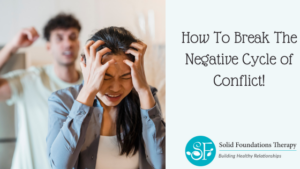
Have you or your partner ever felt like you were just going around and around within conflict, and no resolution appeared to be in sight?
If so; you aren’t alone!
There is a chance that you could be struggling to navigate opposing attachment styles that are stuck in the “negative cycle” of understanding one another.
As you read that, you may wonder what exactly is “The Negative Cycle”?
The Negative Cycle is a negative feedback loop in which couples, especially those in an anxious/avoidant relationship get stuck. The Cycle does two things: one, it blocks the resolution of whatever topic/problem the couple is trying to discuss; and two, it blocks emotional connection and intimacy.
Overall, for a couple to be healthy, they must have the communication skills to use teamwork in order to stabilize their negative cycle and keep it from destroying the relationship.
So, now that we know what the Negative Cycle is, let’s breakdown why some couples find themselves stuck in the negative cycle:
First and foremost, it is important to note that this cycle starts with biology.
All romantic relationships have attachment needs. Early humans were biologically wired to stay connected to other humans in order to be safe. Modern-day humans are still wired to connect. Those who are driven to be in romantic relationships are biologically driven to feel emotionally uncomfortable when the relationship feels threatened, by either a real or perceived threat.
Because insecure-anxious and insecure-avoidant partners feel insecure (due to past negative relationship experiences), they have trust issues and go into relationships with more sensitivity to threats. This is a defense mechanism and keeps these individuals in a hyper-vigilant, protective mode. In turn, it also can cause a gap in the way of connection in those relationships which are mostly safe.
Next, we need to look at attachment needs.
Attachment needs are universal to all humans. Again, think of biology. We first need them to be met by early caregivers (in a child-appropriate way), and later by our romantic partner (in an adult-appropriate way). Some attachment needs will matter more to anxious partners, and some will matter more to avoidant partners.
Some of the most basic human attachment needs are: to feel wanted, to feel appreciated, to know your needs matter to your partner, to know you can trust your partner, to know your partner trusts you, to know you can get it right for your partner, and to know your partner will be there when you need them.
It is important to think of emotional safety in our primary romantic relationship (the person on whom we rely most for emotional support) as a treasure box. Inside the treasure box are our met “attachment needs.” These are the “treasures” needed for partners to stay emotionally safe. When a treasure goes missing, we need to find it to feel complete again.
Then we need to better understand vulnerability.
When an attachment need has gone unmet, it is normal for one to feel extremely vulnerable. The vulnerable emotions most closely associated with unmet attachment needs are fear, grief, and anger. They are meant to be painful, but this pain has a purpose. It’s our body’s way of communicating “something isn’t right.”
If you stepped on something sharp, you would immediately feel pain in your foot. The purpose of the pain would be to communicate to the brain and to you that “I am hurt, investigate the injury. ” This would then elicit a response to cater to your injured foot.
Emotional pain serves a similar purpose. In an attachment context, the purpose of the pain is to get us back to safety with our loved ones. Couples can do this by utilizing an effective repair.
Finally comes the focus on behavior.
Humans inherently do not like to sit in painful or uncomfortable feelings, especially when it comes to attachment. We often will take quick action to do something in order to make the pain go away. We do this in an attempt to feel safe again: This is the focused behavior.
How you behave with your partner in these moments will have to do with your particular attachment style. Anxious individuals will often protest, demand, criticize, blame, or sometimes threaten to leave – all desperate attempts to get their partner to hear them and understand their pain.
Avoidant individuals will often defend themselves, counter-attack, appease, shut down, or sometimes seek comfort elsewhere – all desperate attempts to escape the pain, pretend it’s not there, and/or communicate to their partner “I’m not the bad guy.”
It is important to understand that these particular behaviors will lead to the given partner getting stuck in a Negative Cycle.
These “negative cycle” behaviors will take on a life of their own, and in turn, start reinforcing each partner’s attachment fears (or unmet attachment needs). And as the cycle continues, each partner will become more scared, feel more abandoned, internalize failure, express more anger, state more frustration, adopt a more defeated attitude, feel more powerless, etc.
Things will most likely escalate for a bit, as the couple goes through multiple rounds of the cycle. However, eventually, they will stop, and likely go off on their own to manage their hurt on their own. Both partners will be hurt; avoidants might not look like it on the outside. There can be tension between people for hours, weeks, days, months, and sometimes even years when this cycle goes on uninterrupted over and over again.
It is important to remember that The Negative Cycle is a communication disorder, and when repeated over time, and not repaired, it destroys relationships. But it is also important to remember that it is not hopeless!
So you may wonder how to get out of this negative cycle when you feel stuck in it.

Below are 3 tips on how to best get through the nasty negative cycle when you find yourself in it:
- It’s important to learn to communicate outside of a negative cycle. A positive cycle is a skill that can be learned!
- Seeking professional help from a couples therapist trained in attachment and the negative cycle is an excellent resource. Work with your partner as a team to view the cycle as the enemy. And when it happens, voice that the cycle is happening, and agree to not let it derail the conversation/relationship.
- Come up with a future plan together in order to combat the cycle when it happens again. Find new ways to communicate other feelings besides just your anger (anger is normal and healthy and ok to communicate, but when you are only communicating anger, your partner isn’t getting a full and complete picture. This leaves little to no space for empathy building).
To recap, couples can learn to prevent the negative cycle by naming the problematic behavior, staying curious, validating one another, sharing how things affect you, and reaching for solutions. Don’t let The Negative Cycle destroy your relationship!
Remember that the goal is to not prevent the negative cycle, it is for it to happen less often, be less intense, and for you and your partner to have a faster repair.
If you struggle with conflict resolution and have found yourself in the Negative Cycle, please contact Solid Foundations Therapy today! Visit our website at www.solidfoundationstherapy.com or give us a call at 630-633-8532 today!

